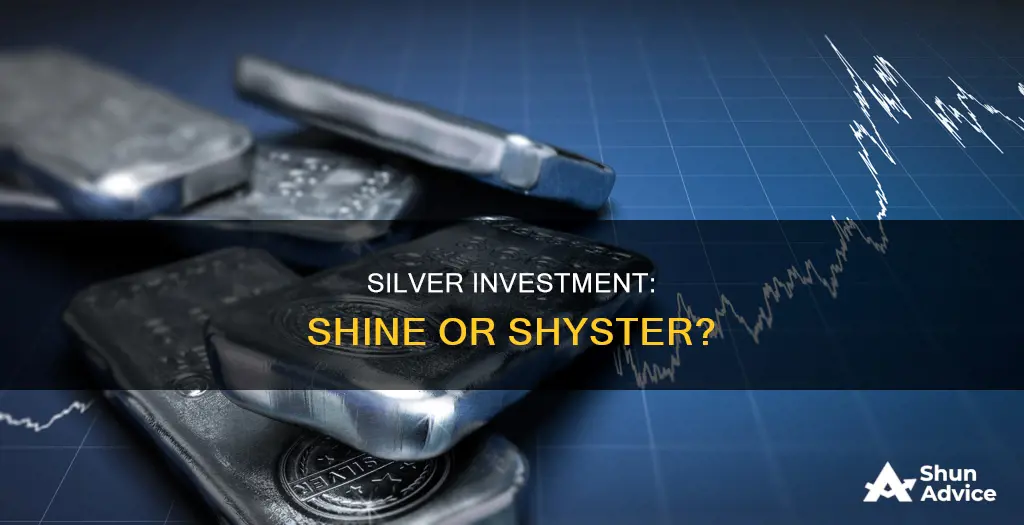
Silver is a popular investment option in the world of precious metals. While it doesn't approach the value of gold by weight, it has many industrial applications in fields such as electronics, making it a good way to diversify your portfolio. Silver is also much cheaper than gold, making it a more accessible investment option.
There are several ways to invest in silver, including buying and storing the physical metal, buying into funds that invest in silver, or owning stock in companies involved in the mining and production of silver.
However, it's important to note that silver is a volatile investment option, and its price movements don't always track the broader economy. Additionally, silver doesn't produce cash flow, so investors looking to profit must rely on someone else paying more for the metal than they did.
What You'll Learn

Silver as a store of value
Silver has been used as a store of value and a form of currency for many years. It is often used as a way for buyers to diversify their portfolios. Silver is also used by investors to diversify because, like other precious metals, it can provide a low negative correlation to other assets. Adding silver to an investment portfolio can decrease risk overall.
Silver is widely recognised as a critical industrial commodity with unparalleled utility. It is the best conductor of heat and electricity and has unique reflective properties, making it indispensable for the growing demand for solar power. Silver also has anti-bacterial properties, making it useful in the medical industry.
Silver's performance has been roughly similar to that of the blue-chip S&P 500 index over the past five years. However, because supply and demand can ebb and flow in the market for silver, its price movements don't always track that of the broader economy. Silver prices are more volatile than gold prices and have higher highs and lower lows.
Silver is a good investment option for those who are slightly less risk-averse. It is far more accessible than gold, making it a good starting point for those interested in investing in precious metals.
People Prefer Spending Over Saving and Investing
You may want to see also

Silver's industrial uses
Silver has a wide range of industrial uses, which account for more than half of the annual demand worldwide. Its unique properties, such as its high electrical and thermal conductivity, make it an essential component in many industries.
Silver is used in electronics, automobiles, mirrors, and water purifiers. It is also used in the energy transition, as it is a key component in solar panels and electric vehicles. In electronics, silver is used in multilayer ceramic capacitors, membrane switches, silvered film, electrically heated automobile windshields, conductive adhesives, and the preparation of thick-film pastes.
Silver is also used in brazing and soldering, helping to produce smooth, leak-tight, and corrosion-resistant joints when combining metal parts. Silver-brazing alloys are used in air conditioning, refrigeration, and electric power distribution.
Additionally, silver has antibacterial properties, which have been utilised in medicine for centuries. Silver dressings, sutures, and bandages are used to treat wounds, burns, and ulcers. Silver is also added to water systems, catheters, and furniture in hospitals to prevent the growth of harmful bacteria.
Investing Together, Retiring Together: A Couple's Guide to Financial Freedom
You may want to see also

Silver's price volatility
Silver is a volatile investment option. Its price movements don't always track the broader economy, and it is subject to boom-and-bust economic cycles. Silver's volatility is exacerbated by the small size of the silver market compared to the gold market.
Silver is much cheaper than gold, so each dollar of investment represents a larger percentage of its price. This can lead to larger price swings, even if the two metals are moving in the same direction. For example, between 2001 and 2011, the price of silver spiked from about $32 per ounce to $64 per ounce, before dropping to below $12 in 2020.
Silver's volatility is also influenced by its industrial applications. It is used in electronics, automobiles, mirrors, water purifiers, solar panels, and electric vehicles. This means that rising consumer prices, which often accompany economic growth and increased demand for goods that use silver, can impact its price.
Additionally, silver's price is influenced by its correlation with gold. Silver often follows gold higher on futures markets, and they tend to move in tandem over the long term. However, silver's price movements can be more volatile in the short term, with silver-to-gold ratios fluctuating between 40:1 and 80:1.
While silver's volatility can present greater short-term opportunities for profit, it also comes with higher risk. Investors should carefully consider their investment goals, risk tolerance, and the overall state of the economy before adding silver to their portfolio.
Government Spending and Private Investment: The Intricate Balance
You may want to see also

Silver bullion and coins
Silver bullion bars and coins are a popular way to invest in silver. Silver is a precious metal that has been coveted for thousands of years and is often used for coins, bars, and jewellery. It is also used in industrial applications, such as electronics, automobiles, mirrors, and water purifiers.
There are several pros to investing in silver bullion and coins. Silver is seen as a safe-haven asset, similar to gold, and can offer protection during times of economic and political uncertainty. It is a tangible asset that is not vulnerable to depreciation in the same way that cash or stocks are. Silver is also a cheaper and more flexible investment than gold, making it more accessible for investors.
However, there are also some cons to investing in silver bullion and coins. Holding physical silver can leave investors vulnerable to theft, and there is a danger of high demand leading to higher premiums. Silver may not perform as well as other investments, and there is a lack of liquidity as silver bullion coins are not legal tender.
If you are considering investing in silver bullion and coins, it is important to find a reputable dealer, watch out for fees, and plan for storage and insurance.
Where Should Retirees Invest Now?
You may want to see also

Silver vs gold as an investment
Silver and gold are both precious metals that have historically been used as legal tender. They are also used in industrial applications, although silver is used much more in this way. Both metals are seen as safe-haven assets, but there are several differences between them that investors should be aware of.
Volatility
Silver is more volatile than gold. Its lower price means that it takes a relatively small amount of money to impact its price. This means that silver will rise more than gold when the market is up, and fall more when the market is down. Silver has historically fallen more than gold in bear markets and risen more in bull markets.
Affordability
Silver is much more affordable than gold, making it more accessible to investors with smaller budgets. Silver is also more practical for everyday small purchases.
Storage
Silver requires much more storage space than gold. At current prices, the same dollar investment will get you roughly 80 times more silver than gold. Silver is also less dense than gold, so it takes up even more space in volume. Silver is also more difficult to transport and will tarnish over time.
Industrial Use
Silver has much higher industrial use than gold. 56% of silver's supply is used in industry, compared to 12% for gold. Silver is used in electronics, medical applications, batteries, and solar panels. Silver is therefore more susceptible to economic booms and busts.
Stockpiles
Governments and institutions used to hold large inventories of silver, but today, only the US, India, and Mexico still have stockpiles. Central banks, on the other hand, hold large amounts of gold in their reserves.
Investment Implications
Silver's higher volatility means that investors must be emotionally prepared for potential big drops. Silver is a good investment for those who believe a new bull market is beginning. Gold, on the other hand, is a better investment for those seeking a lower-risk option.
Liquidity
Both gold and silver are extremely liquid investments. They have been valued commodities of trade for thousands of years and have stood in as currency in many places. Gold is slightly more liquid than silver due to its historical and current status as a currency.
Markups
Dealers will charge a premium on the spot price of both metals. With silver, you can generally find smaller markups for purchases under $1,500. With gold, the markup is typically better for purchases over $1,500.
Summary
Both silver and gold have their advantages as investments. Silver is more affordable and has higher returns in bull markets, but it is also more volatile and susceptible to economic downturns. Gold has lower liquidity and higher markups, but it is a safer investment with a stronger historical connection to currency.
Alchemy Pay: Is This the Future of Crypto Payments?
You may want to see also







